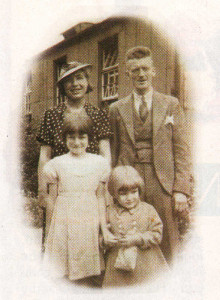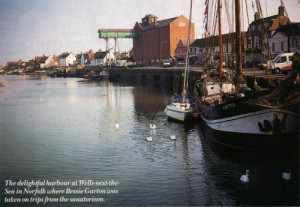I am H.A.P.P.Y. – I am H.A.P.PY. – I know I am, I am sure I am, I am H.A.P.P Y. This refrain was from a song sung frequently through my six-month stay in a local sanatorium in 1936 when, at the age of three, I had the misfortune to catch pneumonia followed by the disease pulmonary tuberculosis (TB). The song was probably meant to cheer us up at during a very unhappy time for all the young patients. The children’s wards in a separate building from the main adult sanatorium were in several wooden buildings which in earlier times had been a fever hospital. It was a high open area near a small spinney, the only treatment in those days being fresh air and rest.
Little Bessie Garton, as she was shyly poses for a family album shot in 1936 at Leicester sanitorium with her parents and elder sister
There were about twenty iron beds in my ward which was heated by a central solid fuel iron stove. We spent most of our time in bed and frequently
the beds were placed out of doors even in very cold weather. The days when we were well enough to get up we attended the hospital school which was in the same complex. Meals were served in the ward at long tables where we sat on benches and used enamel plates and mugs. Sundays would be a time to look forward to as that was visitors’ day when my parents and sometimes my elder sister came to visit bringing fruit and small gifts for me. All the fruit, sweets and chocolate were collected by the staff and stored in a cup board to be shared amongst the patients a little each day. Occasionally, when well enough, I attended Sunday School and the hymn when we would often sing Onward Christian Soldiers. Although there wasn’t any treatment available, we frequently had blood tests and X-rays. All the nursing staff were very kind and dedicated to their work.
The following year I was sent to a convalescent home in Norfolk, a lovely old manor house set in beautiful grounds. When occasionally taken to Wells-next-the-Sea and Sher-ingham, people thought that we were orphans as the girls were dressed in identical gingham dresses. But it proved too far and too expensive for my parents to visit very often so I felt very homesick and lonely. However after six months, I was allowed to return home – and, by the age of 14, I had made a full recovery. Bessie Walker










